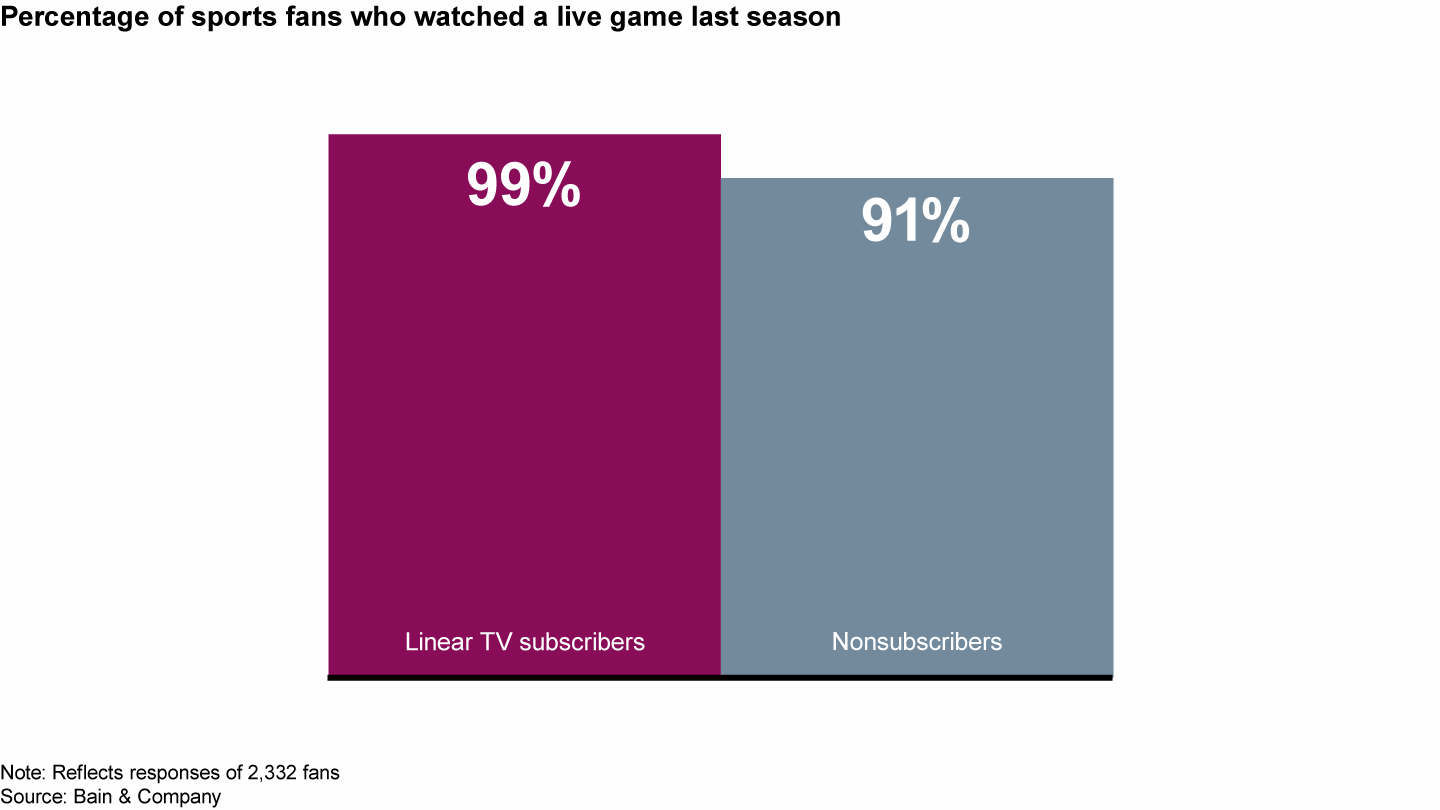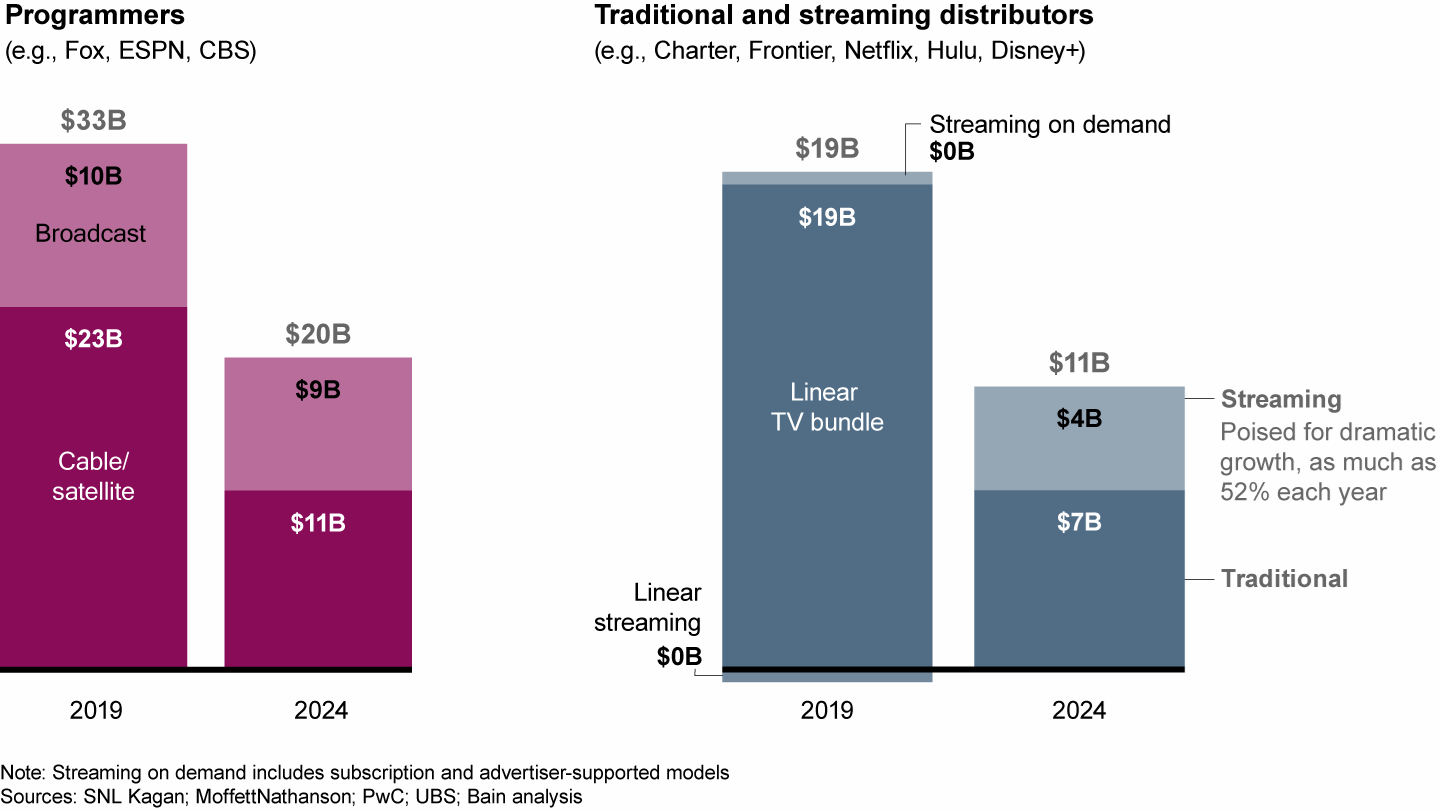Brief

Резюме
- Sports fans in the US, like other media consumers, are beginning to let go of their traditional pay-TV bundles.
- This move follows a broader pattern of profits shifting from traditional programmers and distributors to digital streaming platforms. The revenue implications are significant, not only for media companies but also for the sports leagues that rely on broadcast rights to fund their teams and players' salaries.
- Media companies and sports organizations will have to move assertively to develop new models that meet the evolving needs of sports fans who have cut the cord, without cannibalizing the revenues of traditional pay-TV bundles.
As America’s viewers have shifted away from traditional, linear pay TV, one group of viewers seemed immune to the siren call of streaming: sports fans. While total hours spent watching entertainment on linear pay TV fell by more than a third over the past decade, time spent watching sports dropped by only about 10%.
But fan loyalty only goes so far. Though most sports fans still watch with a pay-TV bundle, some are finding other ways to tune in. Living outside the bundle doesn’t appear to change fan behavior greatly. Most fans watch relatively few of their favorite team’s games each season. And Bain’s research finds that cord cutters are almost as likely to have watched a game as are subscribers (91% vs. 99%), thanks to the ready availability of games on the TVs of friends, family and bars (see Figure 1).
Sports fans still watch games, whether they have a TV bundle or not


A market correction for sports rights
This cord cutting follows a pattern at work for years across the larger universe of broadcast, cable and streaming media. Profits are shifting from traditional linear programmers and distributors to digital streaming platforms. Bain estimates that programmers and distributors as a group could see their profits contract by about 10% per year between 2019 and 2024, though some will do better than others (see Figure 2).
Earnings for programmers and distributors could fall 10% annually through 2024


As profits decline, programmers will pay less for sports rights that fund leagues and teams. Leagues rely on this revenue to invest back into the sport, including the teams, the players and the support staff.
Further complicating the situation, new rights deals for the National Football League—the most significant share of sports rights in the US—could crowd out funding for other sports. Competing leagues will have to manage more uncertainty about how to fund the long-term health of their sport. Major League Baseball, for example, faces significant challenges with its aging fan base, player contract guarantees and dependence on the traditional broadcast distribution model to fund the sport.
An emerging playbook for the sports ecosystem
How will programmers, distributors, and the leagues and teams adapt to a rapidly approaching reality in which one-third of sports viewers have stopped paying for a traditional bundle?
The future state will almost certainly evolve to a hybrid model that combines revenues from linear and streaming content. To do this, leaders will develop direct-to-consumer offers with enough content and price differentiation to set them apart from the linear service without destroying it. At first, these direct offers may simply serve to prime the pump―for example, as a smaller collection of viewing opportunities across a season, for fans who anticipate watching only a handful of games, rather than the every-game faithful.
As technology evolves, these direct offers could become more sophisticated, including access to more data on player and team performance, new betting opportunities, or more interactive and immersive viewing modes. Managing the tension between traditional and new forms of distribution will become one of the most important strategic imperatives for the sports ecosystem.
Many have already started to experiment with expanded media offers, including some of the following:
- Game packaging. Since most fans watch only a few games, programmers and distributors will develop various packages that appeal to different fan segments. They will have to determine what types of streaming game packages minimize risk of luring superfans away from the bundle.
- Price differentiation. Distributors will have to find the right premium to charge for games outside the traditional bundle, often in smaller packages offering just a few games. Meanwhile, superfans, who watch more games than most, may be willing to pay more for a complete package.
- Value-added services. All nongame content, which has little effect on affiliate fees, should shift to digital platforms. Data on how viewers consume this content can deliver insights that create new value and redefine fan engagement.
Implications beyond sports
For sports leagues, teams and broadcasters, the trend away from traditional pay-TV bundles represents a disruptive shift bordering on an existential crisis. But it’s part of a trend affecting the entire media landscape. Those who can break down the economics of the content bundle and recreate that value in a hybrid model of linear and streaming distribution will be the ones most likely to maintain their competitive advantage.